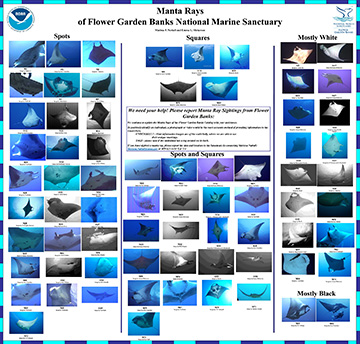TELL US ABOUT YOUR TRIP!

Please tell us about your visit and any interesting observations you might have made. Sanctuary staff and researchers can't be on site as much as they'd like, so we really appreciate reports from recreational divers like you.
top of page
SHARK & RAY OBSERVATIONS

What kind did you see? How many? What sex were they? How big were they? Where did you see them? When?
If you spot a manta ray, and are able to get a photo or video of the underside, we can compare it to other images and reports. Individual manta rays can be identified by the characteristic spot patterns on their bellies.

So far, about 60 individual manta rays have been identified at the sanctuary. To learn more about these animals and what their identifying marks are, please visit our Manta Catalog. Perhaps you'll be able to match your sighting to an already known manta ray, or verify that you've seen a new one.

If you are lucky enough to see a whale shark, we are interested in receiving images of the area between the gills and the first dorsal fin where the spot patterns can help identify the individual animals. We are keen to find out whether these animals are the same ones visiting other Caribbean areas such as Belize and Mexico.
Download an Animal Sighting Report Form
top of page
SEA TURTLE OBSERVATIONS

What kind did you see? What sex were they? How big were they? Where and when did you see them?
Resident loggerhead sea turtles are often encountered resting under ledges and an occasional hawksbill sea turtle is seen snacking on sponges. Many of them have barnacles on their shells which may be used to help identify individuals.

If you are close enough for a shot of a sea turtle's shell (carapace), we'd appreciate you sharing it with us. Please take great care not to aim your lights or strobes directly into the face of the turtles.
Download an Animal Sighting Report Form
top of page
OTHER SIGHTINGS

Let us know if you see:
- Spawning by ANYTHING!
- Animal or plant species you didn't think lived in the sanctuary, such as Acropora corals (elkhorn or staghorn)
- Invasive species
- Damage to the reef, such as breakage, disease, or bleaching
- Suspected regulation violations, such as spearfishing or anchoring
- Anything that doesn't seem quite right
If you see any of these things, please get a heading and distance to the closest mooring so that we may document your finding. Photos or video are very helpful, too.
Download an Animal Sighting Report Form
Download a Violation Report Form
SUBMITTING A REPORT
Just fill in the requested information in the forms linked above, and return by mail, email, or fax to:
Attn: Sanctuary Observations
Flower Garden Banks National Marine Sanctuary
4700 Avenue U, Building 216
Galveston, TX 77551
fax: 409-621-1316
email: flowergarden@noaa.gov
If you'd like to notify us by email, you may attach the appropriate form or simply include the same information in the body of the email.
Observing these fabulous creatures is an awesome experience, but don't get too carried away in the moment. Please keep in mind that we are more concerned with the animal's welfare and comfort level, than we are in getting super close-up shots!
Also think about your safety when you are considering getting the photo (e.g. that whale shark may be too shallow in the water column for a safe ascent to get close).
And, as always, take pictures, but don't touch or do anything to change the direction or movement of the animal, or its behavior.
top of page